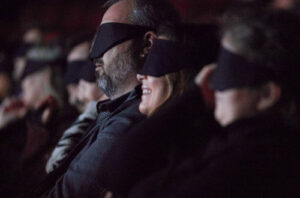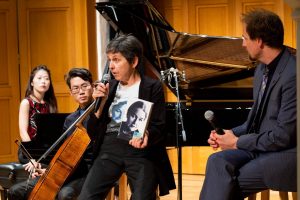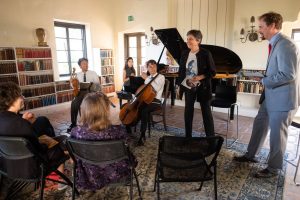Salastina Music Society carried out a remarkably original experiment last weekend (Oct. 6 & 7) – raising issues of how and why some works get into the classical music canon – and some works don’t. Salastina’s two directors were struck by a certain piano trio, and astonished that they hadn’t heard of it previously. So much so that they decided to turn the concert into an event (titled “Sounds Mysterious”) — a discussion of these issues, and to make the case very provocatively, with a “blind taste test.” Moderator Brian Laurizen compared the process to a friend asking you to go out to dinner, to a restaurant that serves food that is, well – a surprise. It is hard to imagine someone going through such an experience for a restaurant (and would you have to be blind-folded?), but with a concert offering, the result was so successful that we wondered if it might be done on a wider basis.
By way of introduction, Lauritzen pointed out (and the musicians obliged with examples) some features of the work that help us recognize its greatness – how we sense it is a masterpiece: for instance, the atmospheric, sensual beauty of the middle of the second movement; the piercing beginning motive that is brought back as a framing device in the last movement, and the closely related thematic vocabulary of the entire work that knits the expansive piece tautly together – motives are subtly transformed, turned into accompanying figures and reworked into different motives.
After this aural “program note” the Salastina musicians – Kevin Kumar (violin), Yoshi Masuda (cello), and HyeJin Kim (piano) launched into their vigorous performance of this 25-minute long work. The audience was quite bowled over and applauded energetically. And then the guessing began. Audience members did zero in on the first half of the 20th century and suggested various possibilities: French origin, eastern European influence, American and 20th-century — figures including Messian, Stravinsky and Berg were named. Laurizen then offered some examples of who it might be – with brief excerpts by the named composers played by the musicians: the French influence suggested Ravel, Lauritzen himself had thought of the sound-world of Samuel Barber, further possibilities were Ralph Vaughan Williams, Ernest Bloch, and Dmitri Shostakovich.
Then the dramatic “reveal” – it was the Piano Trio of 1921 by Rebecca Clarke (1886-1979). Co-director Maia Jaspar White commented that, she, as a string player, had known Clarke’s Viola Sonata “forever,” but saw Clarke as a “one-hit wonder” with that work, and hadn’t encountered other works by Clarke until she and co-director Kevin Kumar consciously started looking for repertoire that was new to them. And I was brought up to the stage as an expert on Clarke and President of The Rebecca Clarke Society, Inc.

The unusual program means an unusual bio.
The following discussion raised many issues, including that we still do not have the expectation that the creator of a masterwork might be a woman – none of guesses or possibilities raised were female. I mentioned the fact that Clarke wrote both the Trio and the 1919 Viola Sonata for competitions which allowed her music to be considered anonymously – and thus avoid the evaluation of her work according to notions of feminine abilities and weaknesses prevalent at the time. I’ve suggested that the anonymous competitions allowed her to write pieces that are distinctively large, aggressive, and boldly assertive.
Another issue is that success can be simply a factor of luck. Robert Schumann happened to like and promote Johannes Brahms’ music — but what if he hadn’t? In Clarke’s case, the radio journalist Robert Sherman interviewed her and featured her music 1976 – it was quite a bit of luck and then that led to her re-discovery, one that still continues to unfold. But what if he hadn’t met with her?
As a woman Clarke faced all kinds of obstacles: for instance, she had quite a hard time with publishers, with the result that only a small part of her output was printed in her lifetime. Her British contemporaries E.J. Moeran and John Ireland were not extremely well-known or incredibly successful, yet both had publishers who took all their works. Institutions such as Universities and male-only clubs offered opportunities to men, and even the co-educational music conservatories had practices of sex-segregation and distinctive expectations for men and women pupils.
Salastina’s ground-breaking format – to strip away context from the work – makes us confront our own expectations, and realize that prejudices — our own, and those that influence artistic programmers – can keep us from hearing a great wealth of music. Let’s hear it for this experimental “listening practice,” without the baggage that in the past has left so much great music on the margins!



